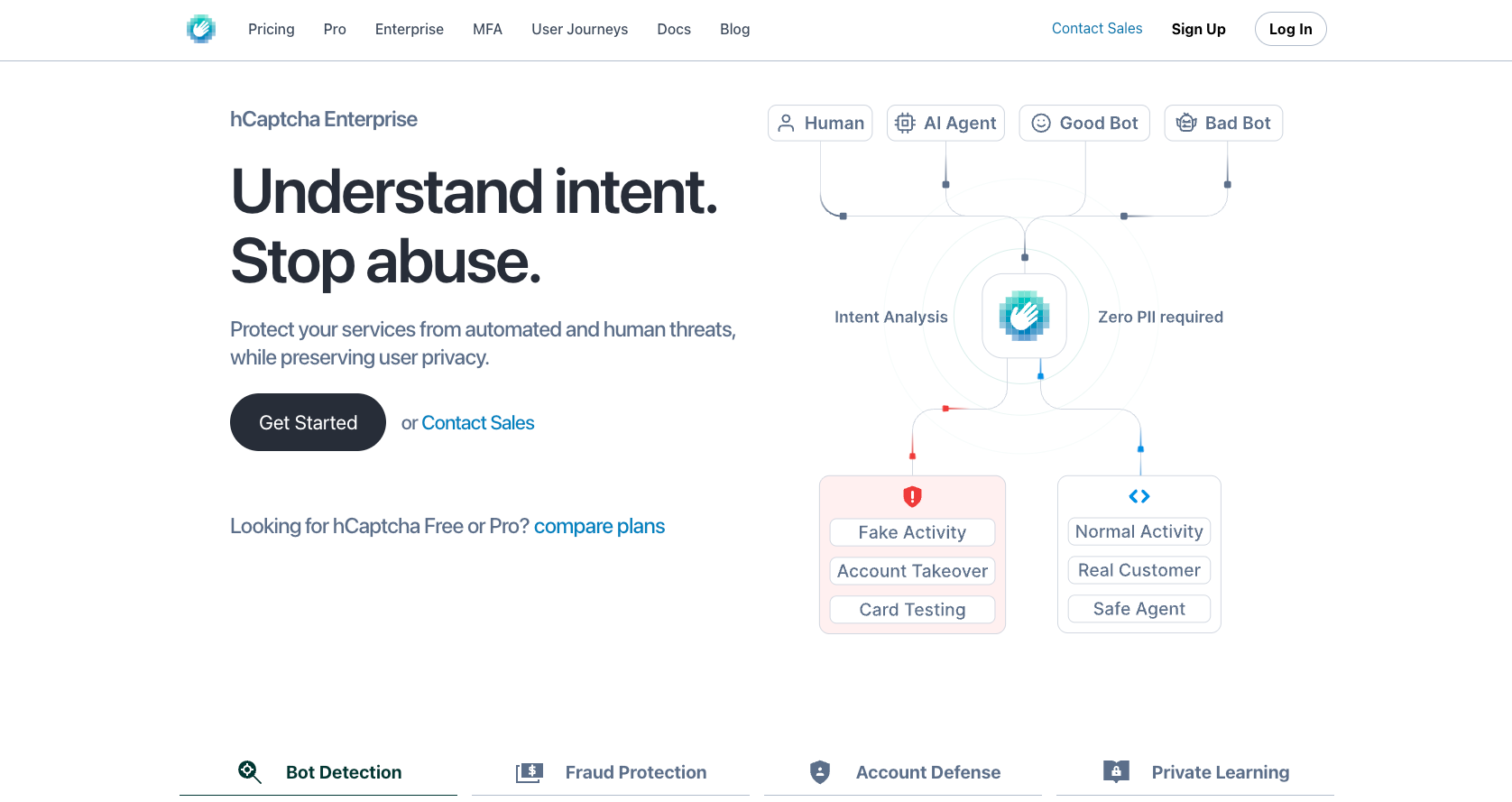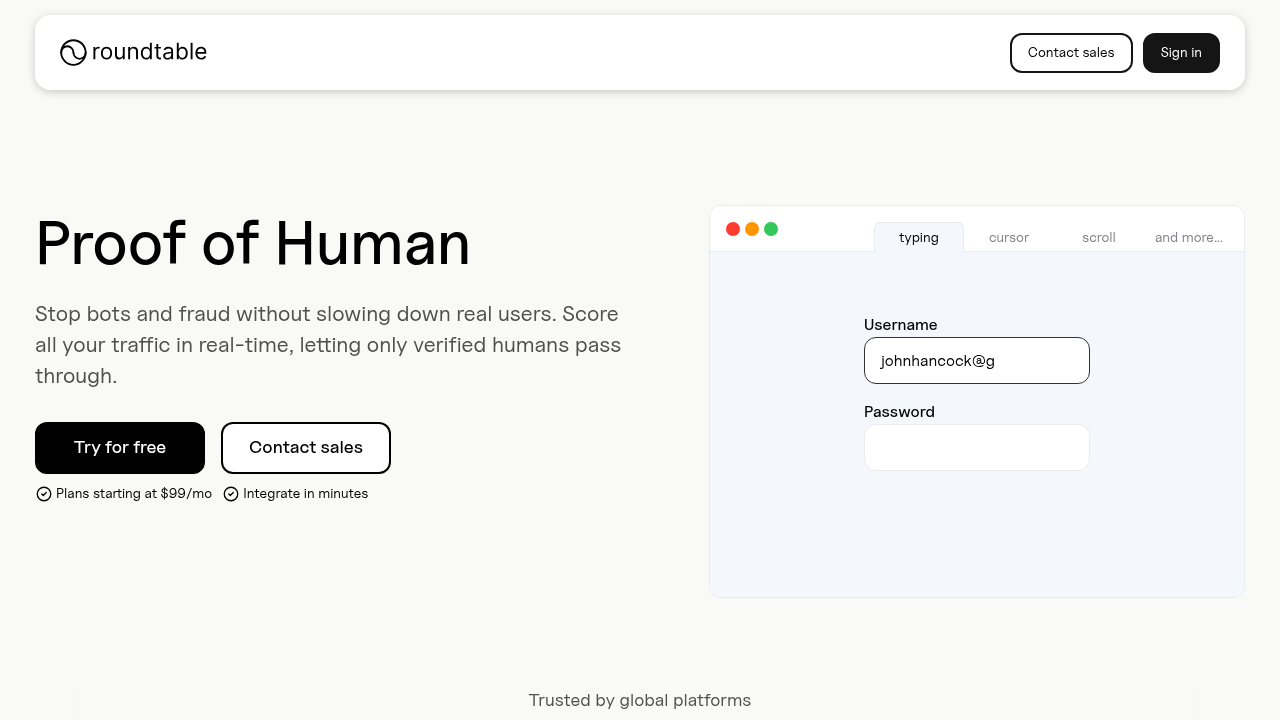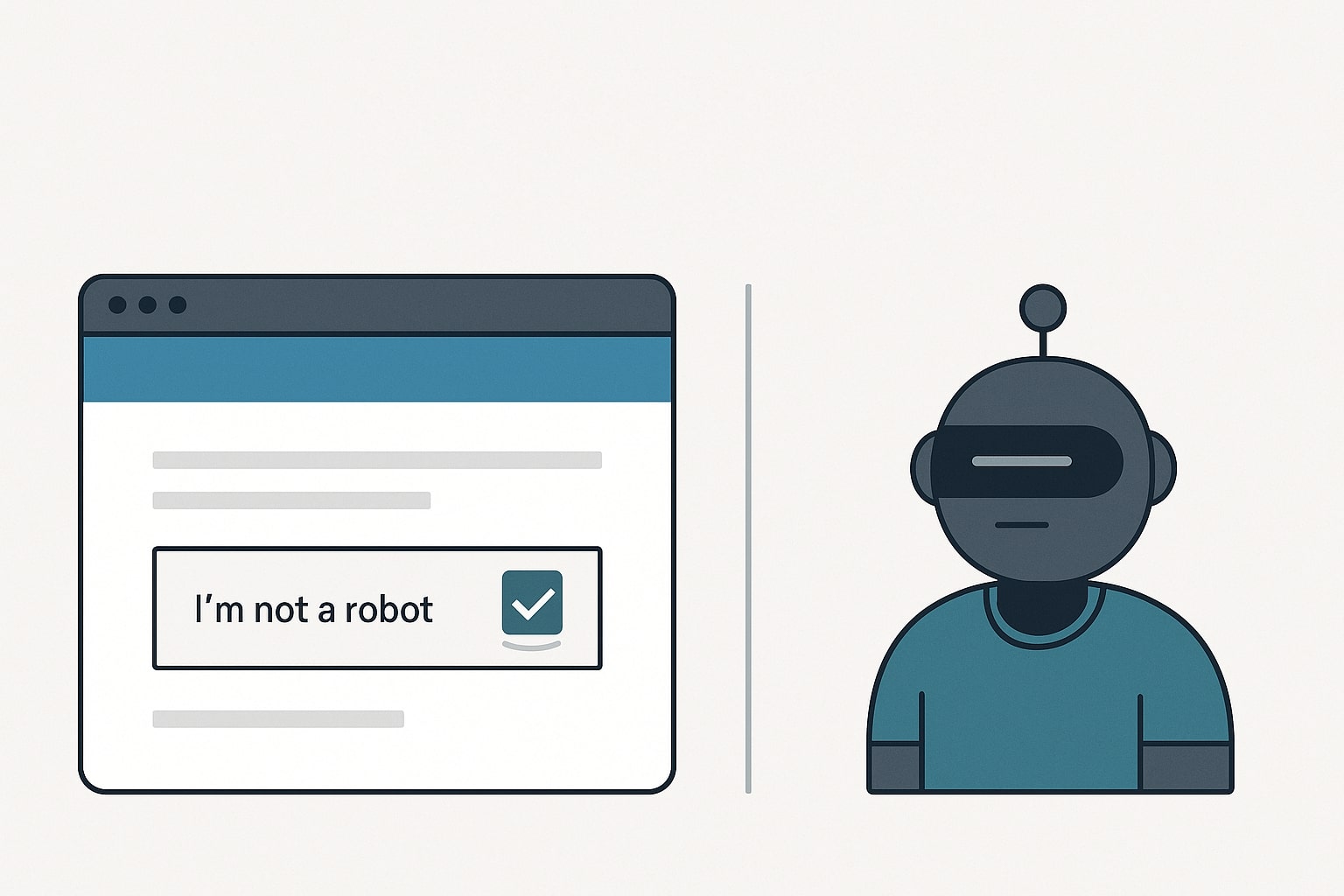11/17/2025. Looking at
bot protection comparison options means deciding what kind of experience you want your users to have. Some tools interrupt people with puzzles and checkboxes, banking on the idea that humans can solve these challenges while bots can't. Others watch how visitors type, move their mouse, and scroll through pages to spot automated behavior without asking anyone to do anything. Both approaches claim to stop bots, but only one does it without making your legitimate users prove themselves over and over.
TLDR:
- hCaptcha shows puzzles that interrupt users and AI bots now solve up to 60% of these challenges
- Roundtable detects bots invisibly with 87% accuracy by analyzing typing patterns and mouse movements
- You integrate Roundtable with one line of code and get protection without losing legitimate customers
- Roundtable verifies users through behavioral biometrics without collecting personal data or requiring consent
What is hCaptcha?
hCaptcha is a CAPTCHA service that verifies users are human by presenting interactive challenges. When you visit a website protected by hCaptcha, you'll encounter a checkbox or an image recognition puzzle asking you to identify specific objects like bicycles, traffic lights, or crosswalks. Th e service operates similarly to Google's reCAPTCHA v2, relying on users to manually solve visual tasks. These challenges analyze your responses to determine whether you're a real person or an automated bot attempting to access the site. hCaptcha markets itself as a privacy-focused alternative to Google's offering without selling user data. The company also pays websites for each challenge completed on their site, creating a revenue-sharing model that's attracted publishers and content creators.
For enterprise customers, hCaptcha offers passive detection modes that aim to reduce friction by running background checks. According to their documentation, these passive modes can verify users without presenting a challenge in
99.9% of cases for qualifying traffic. However, like other challenge-based systems, hCaptcha still interrupts users when its passive detection isn't confident enough to verify them automatically.
What is Roundtable?
Roundtable verifies users without presenting challenges or interrupting their experience. The system analyzes how visitors interact with a website to determine whether they're human, never asking them to click checkboxes or identify images. The service monitors behavioral signals like typing patterns, mouse movements, and scrolling behavior. These metrics reveal whether someone is genuinely navigating a site or running an automated script. Humans naturally exhibit organic typing rhythms and fluid mouse movements, while bots often display programmatic typing or instantaneous "teleporting" between page elements.
Roundtable combines behavioral biometrics with device and browser intelligence to create real-time risk scores for every session. This multi-layered approach catches sophisticated bots that might spoof basic attributes while legitimate users pass through without interruption. The verification process happens in the background through a lightweight JavaScript snippet. You integrate Roundtable by adding a single line of code to your site, and the system returns detailed session reports that you can use to block suspicious traffic before it causes harm.
Challenge-Based vs Invisible Detection
At the heart of selecting a bot-detection system is a single question: "do I want to require my users to do something, like solve a puzzle, or would I rather have a solution that works invisibly in the background?"
Challenge-Based
Challenge-based approaches, like hCaptcha, show visual puzzles when its passive detection flags suspicious activity. These challenges range from simple checkbox clicks to
complex image recognition asking users to identify obscure objects like laughing dogs. This escalation creates friction during critical moments. A legitimate user rushing to complete a purchase suddenly faces multi-step verification that disrupts their flow. Each additional puzzle increases abandonment likelihood, particularly damaging for conversion-focused pages.
Invisible Detection
This kind of approach, like what Roundtable offers, runs entirely in the background, analyzing how people naturally interact with websites. Typing cadence, mouse acceleration patterns, and scrolling behaviors all provide verification signals without requiring conscious action. Your legitimate users never know our security exists. They complete registration, checkout, or login as intended while bots get filtered out based on their inability to replicate authentic human behavior patterns.
Detection Accuracy and Performance
Of course, bot detection accuracy and performance are a critical part of the selection criteria. Even if, in the case of invisible detection, the solution doesn't create user friction but lets 25% of bots through, it may not be the best choice. Compare hCaptcha and Roundtable with this in mind.
hCaptcha Accuracy and Performance Overview
hCaptcha's challenge system depends on users correctly identifying images. When passive detection flags suspicious activity, the service escalates to visual puzzles that range from simple to complex. The approach faces a fundamental problem: AI models are getting better at solving these challenges.
Advanced bots can now solve up to 60% of traditional image-based CAPTCHAs, making the challenge model increasingly ineffective against well-resourced attackers. hCaptcha's invisible mode attempts to reduce friction, but it still falls back on challenges when risk signals aren't conclusive.
Roundtable Accuracy and Performance Overview
Roundtable achieves 87% detection accuracy by analyzing behavioral patterns that bots struggle to replicate convincingly, using
bot detection methods that monitor keystroke dynamics and mouse movements. The system monitors keystroke dynamics, mouse acceleration, scrolling behavior, and dozens of other signals simultaneously. This multi-layered detection approach creates economic barriers for attackers. Sophisticated bots would need to perfectly simulate human behavior across multiple dimensions consistently. The cost and complexity of doing so at scale makes Roundtable's protection model more resilient against evolving threats than puzzle-solving challenges.
Privacy and Compliance Approach
Privacy and compliance are critical decision points when selecting a bot-mitigation approach, especially as governments and regulatory bodies, like the EU for example, are banning tracking cookies.
How hCaptcha Addresses Privacy and Compliance
hCaptcha requires cookies to function, which triggers consent requirements under GDPR and CCPA, raising
CAPTCHA accessibility concerns. Each image puzzle generates data about user selection patterns, timing, and interaction behavior that the system analyzes to verify humanity. As a US-based service, hCaptcha also relies on international data transfer frameworks that face ongoing legal challenges with EU data protection requirements.
How Roundtable Addresses Privacy and Compliance
Roundtable analyzes behavioral patterns like typing cadence and mouse movements without collecting personally identifiable information. This approach processes technical metrics and behavior signals that fall outside personal data definitions, eliminating the consent requirements that challenge-based systems trigger.
Integration and Implementation
At the end of the day, a technology is only as good as it is easy to set up. If it requires extensive integration or specialized components that end users must install, it might not be the best choice.
hCaptcha Integration and Implementation Overview
hCaptcha requires embedding challenge widgets into web forms and interfaces. This involves modifying your frontend to display puzzle overlays and connecting your backend to verify each challenge response through their API.
The implementation carries ongoing maintenance requirements. Your team needs to balance security strictness against user experience, tweaking when challenges appear and how difficult they should be. Too aggressive, and legitimate users abandon transactions. Too lenient, and bots slip through.
Roundtable Integration and Implementation Overview
Roundtable requires adding one line of JavaScript to your site. The snippet loads invisibly and begins analyzing behavioral signals immediately, without any frontend challenges to design or position. Our API returns detailed session reports with risk scores and fraud indicators for each visitor. You decide how to handle flagged sessions through your existing backend logic, whether that's blocking suspicious traffic, requiring additional verification, or flagging for manual review.
Most implementations finish within days, not weeks. There's no challenge UI to build, no escalation flows to design, and no ongoing optimization of puzzle difficulty.
Why Roundtable is the Better Choice
Challenge-based systems force you to choose between security and conversion rates. Each puzzle adds friction at registration, checkout, and login, creating drop-off points that cost you legitimate customers. Meanwhile, AI capabilities continue solving these challenges with increasing accuracy. Roundtable removes this tradeoff by analyzing behavioral patterns that bots can't replicate at scale. You get 87% detection rates without interrupting legitimate users. No puzzles to solve, no images to identify, no friction at conversion points.
The choice comes down to whether you're willing to keep losing real customers to challenges that sophisticated bots already bypass.
FAQ
How does invisible bot detection work without showing challenges?
Invisible detection analyzes behavioral patterns like typing rhythm, mouse movements, and scrolling behavior that naturally occur as users interact with your site. Bots can't replicate the organic variations in human behavior across multiple dimensions simultaneously, making these signals reliable verification methods without requiring any conscious user action.
What happens to legitimate users who get flagged by mistake?
Roundtable's human-in-the-loop workflow flags suspicious sessions for review instead of automatically blocking them, reducing false positives compared to aggressive systems. Usually only 10-30% of sessions typically need manual review, and this approach can save over 60% of review time while protecting real customers from being mistakenly turned away.
How long does it take to integrate Roundtable into an existing website?
Integration requires adding a single line of JavaScript to your site, with most implementations completed within days. The lightweight snippet loads invisibly and begins analyzing behavioral signals immediately, without requiring challenge UI design, escalation flows, or ongoing puzzle difficulty optimization.
Can AI bots solve traditional CAPTCHA challenges effectively?
Advanced AI models can now solve around 28-60% of traditional image-based CAPTCHA challenges, making challenge systems increasingly ineffective against well-resourced attackers. This growing capability explains why behavioral analysis provides more resilient protection than puzzle-solving approaches.
What detection accuracy can I expect compared to challenge-based systems?
Roundtable achieves 87% detection accuracy by analyzing behavioral patterns across multiple dimensions simultaneously. This multi-layered approach outperforms challenge systems that bots are learning to solve, creating economic barriers for attackers who would need to perfectly simulate human behavior at scale.
Final thoughts on the hCaptcha alternative
When you compare
hCaptcha vs Roundtable, you're really deciding whether to keep using a system that frustrates users and barely stops sophisticated bots. Challenge-based detection made sense years ago, but behavioral analysis catches threats that puzzles miss while your legitimate traffic flows through uninterrupted. The math for selecting an invisible bot-detection solution like Roundtable is simple: better detection rates, zero user friction, and no puzzle fatigue driving people away from your site.


